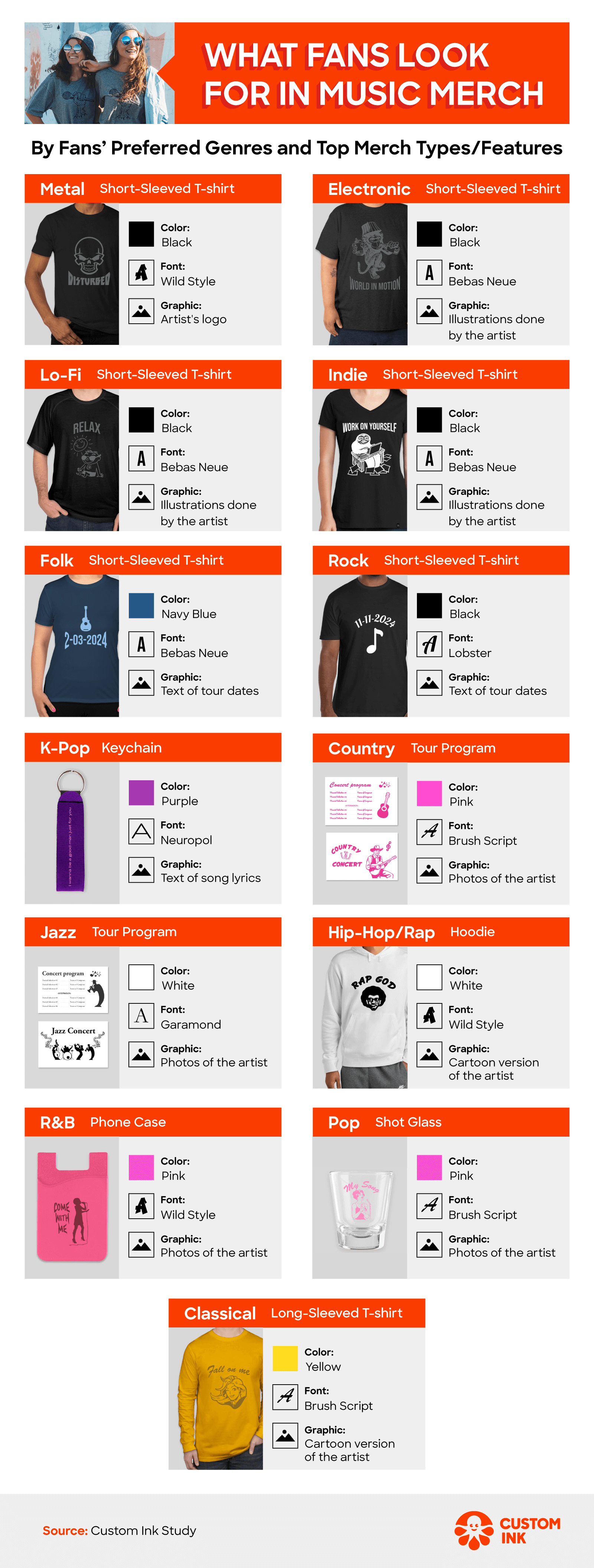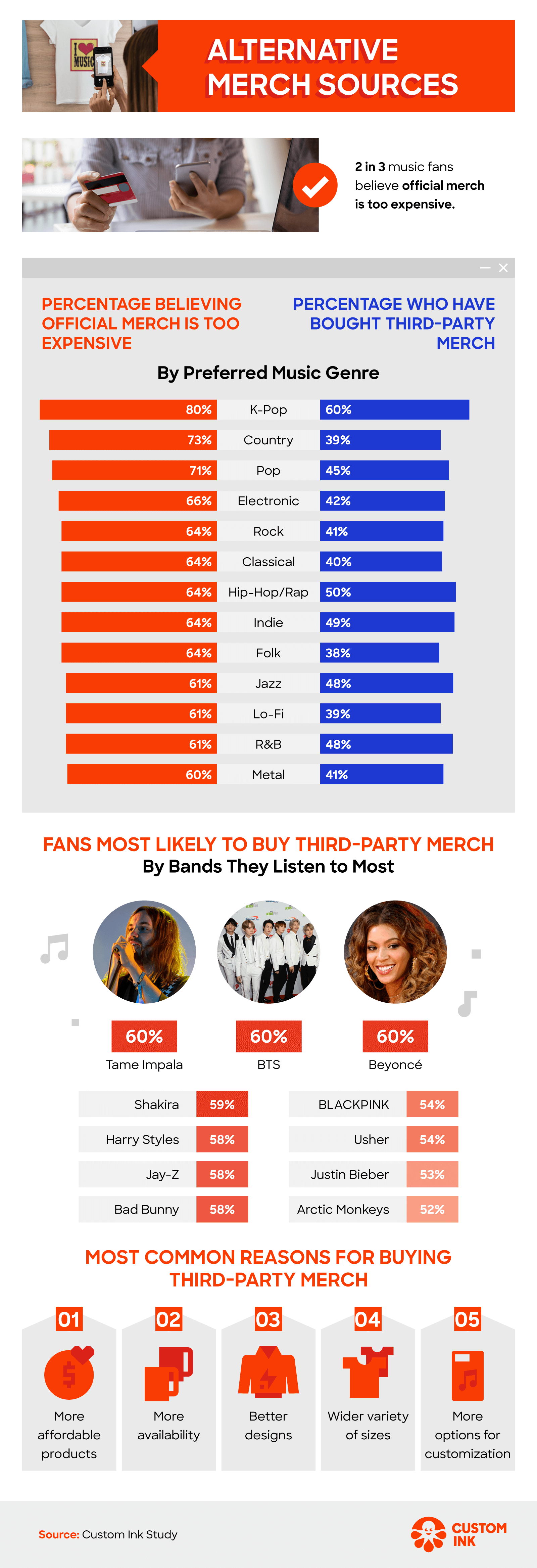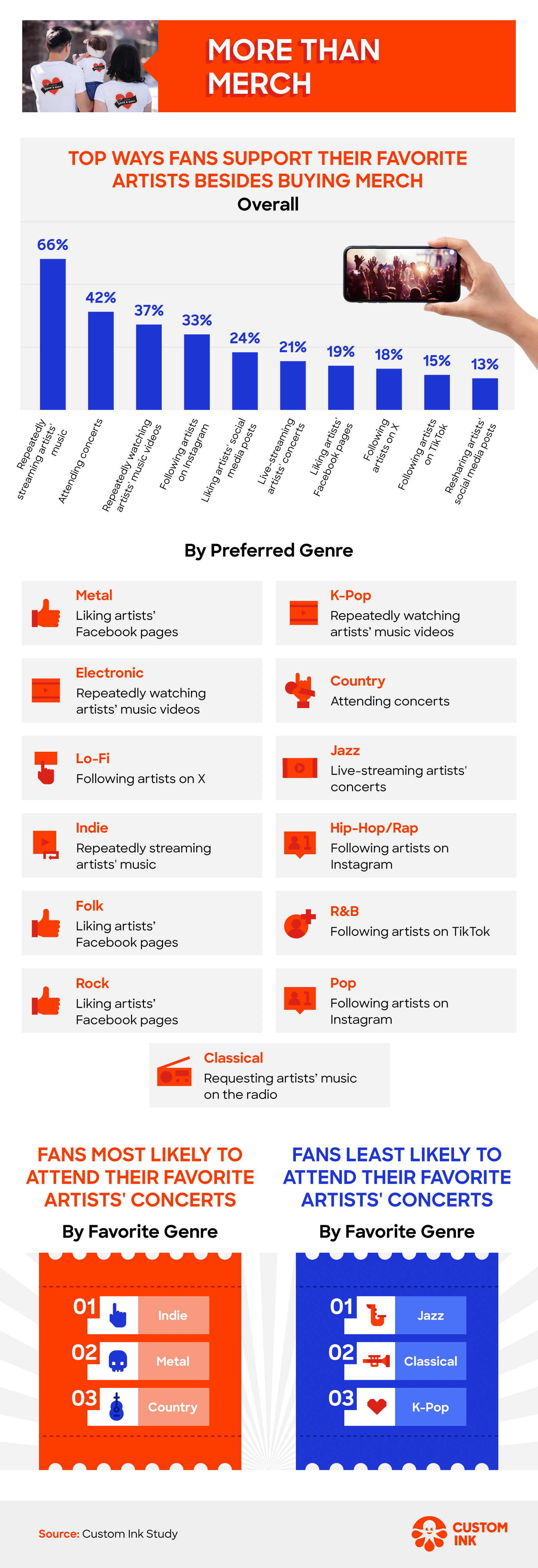How Americans Promote Their Favorite Musicians
 How music fans support their favorite artists has evolved far beyond attending live shows and buying albums. Music enthusiasts express their admiration in many ways, from sporting branded merch to streaming tracks on repeat and following social media pages. But what types of music merch do fans want, and where do they want to buy it? Which platforms are they most interested in for listening to or watching their favorite musicians?
How music fans support their favorite artists has evolved far beyond attending live shows and buying albums. Music enthusiasts express their admiration in many ways, from sporting branded merch to streaming tracks on repeat and following social media pages. But what types of music merch do fans want, and where do they want to buy it? Which platforms are they most interested in for listening to or watching their favorite musicians?
In this article, we’ll explore these aspects of music fandom, highlighting how fans of various artists and genres show their support through merchandise, digital engagement, and live event attendance. Ready to explore the symphony of support that keeps the music industry vibrant? Let’s hit play.
Key Takeaways
- Metal, electronic, and lo-fi fans buy the most merch.
- K-pop fans spend the most on merch per month, averaging $35.
- K-pop fans are the most likely to buy third-party merch; metal fans are the least likely.
- 2 in 3 music fans repeatedly stream an artist’s music to show their support.
- Indie, metal, and country fans are the most likely to support their favorite artists by attending a show.
2024 Merch Trends
From metal to K-pop, we uncovered the types of merch different music fan communities prefer to buy in support of their favorite artists.




More metal fans purchased merch than any other music genre’s fans in our study — 40% of them, to be exact. Electronic and lo-fi fans followed, with 31% and 30% saying they buy artists’ merch. But, when it came to how much fans have spent annually, K-pop enthusiasts stood out, averaging an impressive $418 in the past year. This finding tracks, given the growing fervor of the K-pop fandom.
Looking at yearly merch spending by favorite artists, BTS fans spent the most of all K-pop fans at $826 per year. Here’s how that stacked up against other artists in terms of the top-spending fans of each genre annually:
- Pop: Justin Bieber, $434
- Metal: Iron Maiden, $422
- Rock: Arctic Monkeys, $395
- R&B: Usher, $348
- Indie: Bon Iver, $346
- Hip-Hop/Rap: Kendrick Lamar, $329
- Jazz: Billie Holiday, $269
- Country: Tim McGraw, $244
- Folk: Simon & Garfunkel, $156
Men and women were about equally as likely to buy merch to support their favorite artists: 46% of women and 44% of men. Looking at the generational distinctions, Gen X was most likely to do so (49%), followed closely by millennials at 46% and baby boomers at 43%. Gen Z fans were the least likely, with only 32% purchasing merchandise. Maybe younger fans support and engage with their favorite artists in other ways.
Want to know more about what fans want from their favorite artists? Take a look below at the top merch types and features (including colors, fonts, and graphics) by music genre. Spoiler alert: black short-sleeved t-shirts are a winner.




Shopping Elsewhere for Merch
These days, you don’t have to show up at a concert to buy merch. Next, we examine which fans are most likely to shop elsewhere and why.




Although they’ve spent the most on merch (as we discovered in the last section), K-pop fans were the most likely to balk at high merch prices and buy merch from third-party vendors. But they’re not alone; fans across genres expressed an overall preference for unofficial merch due to cost, design quality, and availability.
But metal fans disagreed — they were the least likely to buy third-party merch, perhaps valuing the authenticity of official merch or having more access to it due to attending more shows. They also own the most band t-shirts of any other music fan base.
Third-party merch draws in a broad spectrum of music lovers. Fans of Tame Impala, BTS, and Beyoncé were the most likely to buy this unofficial merchandise. Maybe they were attracted by unique designs that resonated with them better or by the easier access or lower prices these items can offer.
Here’s a glance at the artists whose fans were most likely to buy third-party merch, listed by artist genre:
- Metal: Slipknot
- Indie: Bon Iver
- Folk: Bob Dylan
- Rock: Arctic Monkeys
- K-Pop: BTS
- Country: Dolly Parton
- Jazz: Ella Fitzgerald
- Hip-Hop/Rap: Jay-Z
- R&B: Usher
- Pop: Beyoncé
The likelihood of buying third-party merch also varied by certain demographics. Women (45%) were slightly more likely than men (40%) to opt for these alternatives. And although Gen Z was the generation least likely to buy music merch overall, they were the most likely to buy third-party merch (48%), followed by millennials (47%). These figures contrasted with 38% of Gen X and just 26% of baby boomers.
These preferences suggest that many fans balance their desire to connect with their music idols with practical considerations around cost and quality.
Other Avenues To Support Artists
There’s no shortage of ways to engage with musicians and support their art in this digital era. Let’s see the most common methods among various fanbases, from social media to good old-fashioned concert attendance.




Two-thirds of music fans have supported their favorite artists by hitting play on their music over and over on streaming platforms, pointing to digital consumption as a means of backing musicians. Similarly, electronic and K-pop fans have repeatedly watched artists’ music videos, adding a visual component.
Musicians can also find a sea of fan support on social media, where metal, rock, and folk enthusiasts often express their fandom by liking artists’ Facebook pages. Meanwhile, country fans have preferred to show support in one of the most time-honored ways: attending live shows. There’s nothing like a live performance to connect with and support musicians.
The Future of Artist Merch and Fan Engagement
The digital age has made the bond between fans and their favorite artists stronger and more multifaceted than ever before. From the tangible connection of merchandise to the digital engagement of streaming and social media interaction, fans have many avenues to connect and show their support.
Official merch prices have many music fans across genres turning to third-party merch for its affordability, quality, and unique designs. Meanwhile, repeated song streaming has taken over attending live shows as the top method for supporting musical artists in other ways. This evolution has changed how we consume music as well as how we contribute to the success and longevity of our favorite artists.
Methodology
We surveyed 1,000 American music listeners about their merch-buying preferences. Among them, 49% were men, 50% were women, and 1% were nonbinary or nonconforming. Additionally, 9% were baby boomers, 27% were Gen X, 50% were millennials, and 13% were Gen Z. For preferred genre analysis, respondents could choose up to three of their favorite genres; 62% selected rock, 54% pop, 32% hip-hop/rap, 21% country, 19% R&B, 18% indie, 14% electronic, 14% classical, 11% jazz, 10% folk, 7% lo-fi, and 6% K-pop. For preferred artists, respondents were allowed to select as many as they wanted, but we only analyzed artists that were supported by at least 5% of our respondents.
About Custom Ink
Custom Ink enriches communities through custom gear, offering innovative design tools, exceptional service, and a vast selection of quality products. We make it easy to express your group’s unique spirit and shared goals, whether it’s your fan base, workplace, or favorite sports team.
Fair Use Statement
If you’re captivated by the ways music fans support their favorite artists and wish to share these insights, feel free to spread the word for any noncommercial use. We only ask that you provide a link back to this page, ensuring your audience can access our full findings and methodology.

Leave a Comment